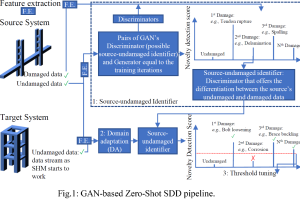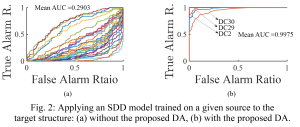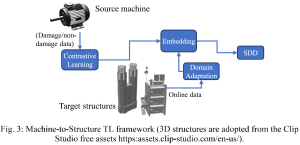IDRE Fellow: Dr. Hesam Soleimani
Faculty Mentor: Dr. Ertugrul Taciroglu
Department: Civil and Environmental Engineering
_________________________________
Urban infrastructure is governed by specific rules, ranging from simpler systems, such as residential buildings, to more critical structures like power, energy, and healthcare facilities. Structural Health Monitoring (SHM) provides a framework for monitoring these systems to ensure service continuity and sustainability in built environments. From an SHM point of view, infrastructure behavior can be classified into non-damaged and damaged states, impacting their ability to maintain uninterrupted services. Before the resurgence of machine learning in 2017, achieving reasonable results in SHM for individual structures, even with considerable historical labeled (damaged vs. non-damaged) data, was challenging, especially given the complexity of SHM-related data, such as noisy accelerometer signals. Today, with the advancements in deep neural networks, SHM with labeled data has become more feasible, even in the presence of various uncertainty sources. However, new challenges arise in monitoring systems without historical data and in the model specificity; models trained for a particular system often cannot be applied to others, limiting the scalability of SHM across urban areas. In large-scale SHM applications, numerous infrastructure types—bridges, buildings, power systems, and others—exist that typically lack system-specific historical data due to not facing damaged states before and the high costs of instrumentation and data storage at this scale.
At the TCR research group within UCLA’s Civil Engineering Department, we identified this problem and are working to address these challenges step by step to develop a reliable, zero-shot SHM model requiring no labeled data that generalize across different systems. Achieving this would represent a significant advancement toward scalable, large-scale SHM practices. To this end, we began investigating methods for building a zero-shot SHM model that relies solely on “online” baseline data from the system as large-scale SHM commences. Leveraging Generative Adversarial Networks (GANs) and their unique objective function—modeled as a game between agents of real and fake data—the SHM problem of distinguishing non-damaged from damaged states can be reframed within GAN’s real and fake domains. This approach allows the GAN discriminator to learn features of non-damaged data in contrast to various potential damage patterns, even without access to observed damaged data. These findings have been published in the MSSP journal [1] (link).
The next step is developing SHM models capable of transferring SHM knowledge across different structures, utilizing Transfer Learning. Adapting Transfer Learning for large-scale SHM presents several challenges. First, the model must also function in a zero-shot setting, where, for a given target structure, only incoming online non-damaged data is available. Second, structures differ significantly in their vibrational characteristics; for example, one might be a bridge affected predominantly by its primary vibration mode, while another might be a multi-story frame susceptible to local damage. Another key requirement is to avoid model fine-tuning, as large-scale SHM applications benefit from a pre-trained model that doesn’t require constant adjustments. To meet these challenges, we leveraged SHM domain knowledge and adopted feature domain adaptation instead of fine-tuning. From a digital signal processing perspective, if we assume the excitation is white noise, two systems—whether a bridge or a rotating machine—will exhibit similar behavior if their response frequency spectrums align. Based on this insight, we developed a physics-based DA strategy to transform target structure features to match those of the source. This enables a single pre-trained SHM model, supported by historical data, to be applied across heterogeneous target structures for SHM purposes. These findings have been published inside the IMAC conference [2] (link).
The current stage of TL for large-scale SHM applications we are currently investigating is how to employ multi-source TL. For the previous studies, a source structure existed from which we had access to rich historical data that we did not have for target systems. Still, from a machine learning point of view, each such benchmark provides us with limited data compared to the hypothetical ultimate representative SHM dataset. Moreover, if a method is built to increase such benchmarks effectively and cost-effectively, then the SHM performance is deemed to be enhanced. Herein, and empowered by the achievements, the earlier DA model is equipped with a Contrastive Learning (CL) module to allow TL across real-world structures and rotating machinery equipment. RMs are known for the Fault Detection problem, almost identical to damage detection for SHM purposes. However, RMs are easy to build into a lab environment, and introducing damage states to them is relatively simple by breaking the bearing disks or other. Thus, various sources can be built easily from RMs, and with the new CL and DA method bundle, we showed that by including several sources larger than one, we could obtain performance equal to or even better than actually having the target system with extensive background data, surpassing a huge limit in large-scale SHM applications, Findings are published in MSSP [3] (link) and Applied Soft Computing journals [4] (link).
To sum up, starting with the simple idea of whether it is possible to seamlessly apply models across structures for large-scale SHM and identify the associated needs, the latest deep learning and machine learning capabilities have been adopted and modified, and a developing framework has been established. Although this endeavor has reached pivotal milestones, the current focus is on understanding how other SHM capabilities can be further enhanced by the proposed methods. This includes damage severity measurement and localization without relying on previously seen damaged data or pre-trained models, which is an ongoing area of work.
References
- 1. Soleimani-Babakamali, Mohammad Hesam, et al. “Zero-shot transfer learning for structural health monitoring using generative adversarial networks and spectral mapping.” Mechanical Systems and Signal Processing 198 (2023): 110404.
- 2. Soleimani-Babakamali, Mohammad Hesam, et al. “Transfer Learning Across Heterogeneous Structures Through Adversarial Training.” IMAC, A Conference and Exposition on Structural Dynamics. Cham: Springer Nature Switzerland, 2024.
- 3. Soleimani-Babakamali, Roksana, et al. “Transferring damage detection knowledge across rotating machines and framed structures: Harnessing domain adaptation and contrastive learning.” Mechanical Systems and Signal Processing 221 (2024): 111743.
- 4. Soleimani-Babakamali, Mohammad Hesam, et al. “Multi-Source Transfer Learning for zero-shot Structural Damage Detection.” Applied Soft Computing (2024): 112519.






